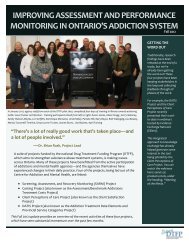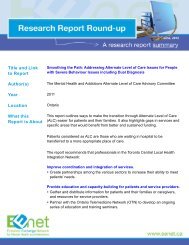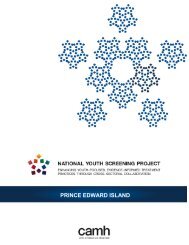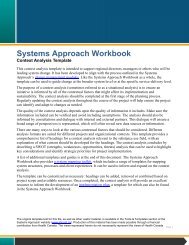Implementation of Early Psychosis Intervention Program ... - EENet
Implementation of Early Psychosis Intervention Program ... - EENet
Implementation of Early Psychosis Intervention Program ... - EENet
Create successful ePaper yourself
Turn your PDF publications into a flip-book with our unique Google optimized e-Paper software.
34o Outreach most <strong>of</strong>ten included providing referral information; many programs also provideeducation, especially to schools and youth services.o Screening tools were used much less frequently - about 40% <strong>of</strong> sites provided primary careproviders with screening tools and fewer provided such tools to hospital, schools or othercommunity referral sources.o <strong>Program</strong> differences were only evident regarding education outreach. Larger programs weremore likely to provide education to primary care and hospital programs than smallerprograms, and community agency sponsored were more likely than hospital sponsoredprograms to provide education to youth services and shelters.o While programs reported disseminating referral information, conducting education andsometimes providing screening support, it is unclear how consistent and comprehensive thisoutreach is. Challenges <strong>of</strong> EPI program staff time and staff turnover were noted.Table 3: Outreach Strategies used with Referral Sources (Q 35)Referral SourcesOutreach StrategiesReferral Info Education Screening ToolsFamily Physicians 96 65 39Hospital Emergency 89 37 23Hospital Inpatient Unit 90 62 29Schools 87 92 25Youth Services 83 71 19Shelters 48 40 4Polices, Corrections 62 48 4Main challenges to developing referral networks noted by programs (see Table 4):o Staff time was mentioned by almost all sites.o Access to the audience was mentioned by 60%, with specific reference to getting into schoolsand family physician <strong>of</strong>fices, and connecting with the police and Children’s Aid Society(CAS).o Maintaining ongoing contact with referral sources was mentioned by about half, and mayalso reflect the challenge <strong>of</strong> staff turnover.o Receiving inappropriate referrals was noted more <strong>of</strong>ten by larger urban programs, whereasnot receiving referrals that should be made was noted more <strong>of</strong>ten by community sites.Table 4: Main Challenges to Developing a Referral NetworkMain Challenges Response (% yes)Staff time 87Access to audience 60Ongoing contact 54Services who should be referring 50Inappropriate referrals 46Tools/resources 0
















